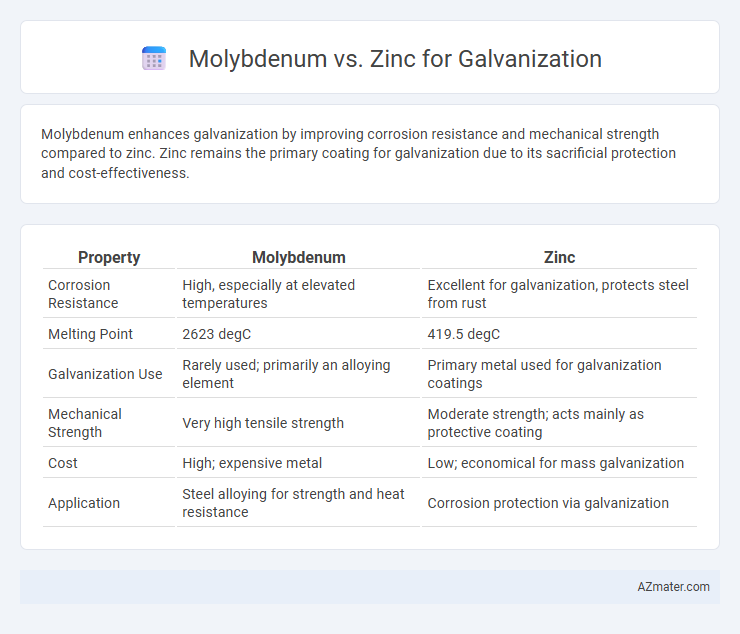Molybdenum enhances galvanization by improving corrosion resistance and mechanical strength compared to zinc. Zinc remains the primary coating for galvanization due to its sacrificial protection and cost-effectiveness.
Table of Comparison
| Property | Molybdenum | Zinc |
|---|---|---|
| Corrosion Resistance | High, especially at elevated temperatures | Excellent for galvanization, protects steel from rust |
| Melting Point | 2623 degC | 419.5 degC |
| Galvanization Use | Rarely used; primarily an alloying element | Primary metal used for galvanization coatings |
| Mechanical Strength | Very high tensile strength | Moderate strength; acts mainly as protective coating |
| Cost | High; expensive metal | Low; economical for mass galvanization |
| Application | Steel alloying for strength and heat resistance | Corrosion protection via galvanization |
Introduction to Galvanization
Galvanization is the process of applying a protective zinc coating to steel or iron to prevent rusting and corrosion, extending the metal's lifespan. Molybdenum and zinc play distinct roles in enhancing corrosion resistance; zinc forms the primary sacrificial layer, while molybdenum is often added as an alloying element to improve stainless steel properties and corrosion resistance under harsh conditions. Understanding the differences between molybdenum and zinc in galvanization applications is essential for selecting appropriate materials for industrial and construction projects.
Understanding Molybdenum in Galvanization
Molybdenum plays a crucial role in improving the corrosion resistance and adhesion of zinc coatings during galvanization by enhancing the microstructure and uniformity of the zinc layer. Unlike zinc alone, which provides sacrificial protection, molybdenum acts as an alloying element that stabilizes the coating and reduces the formation of brittle intermetallic compounds. Understanding molybdenum's function helps optimize galvanization processes for longer-lasting, more durable protective coatings on steel and other metals.
The Role of Zinc in Galvanization
Zinc plays a crucial role in galvanization by providing a protective coating that prevents steel or iron from rusting through sacrificial anode action. Its ability to form a stable, adherent oxide layer ensures long-lasting corrosion resistance even when scratched or damaged. Unlike molybdenum, which is often used as an alloying element for enhancing steel strength, zinc's primary function in galvanization is to act as a corrosion barrier, making it essential in industrial and construction applications.
Comparative Corrosion Resistance: Molybdenum vs Zinc
Molybdenum exhibits superior corrosion resistance compared to zinc, especially in harsh environments with high temperatures and acidic conditions, making it a more durable choice for galvanization in industrial applications. Zinc provides effective sacrificial protection against rust, but it tends to degrade faster in marine or highly acidic atmospheres, reducing its long-term effectiveness. The higher melting point and chemical stability of molybdenum enhance its protective longevity, whereas zinc's lower cost and ease of application make it more common despite its relative susceptibility to corrosion.
Mechanical Properties and Performance
Molybdenum-enhanced galvanization significantly improves mechanical properties such as tensile strength and hardness compared to traditional zinc coatings, providing superior corrosion resistance in harsh environments. Zinc coatings offer excellent sacrificial protection but tend to degrade faster under mechanical stress and aggressive conditions, leading to reduced durability. The incorporation of molybdenum in galvanizing alloys results in enhanced structural performance, making it ideal for applications requiring long-term resilience and wear resistance.
Environmental Impact and Sustainability
Molybdenum enhances the corrosion resistance of galvanized steel, extending the lifespan of coatings and reducing the frequency of replacements, which lowers overall environmental waste. Zinc, as the primary material in galvanization, is highly recyclable and abundant, contributing to its sustainability, though its extraction and processing can carry significant environmental footprints. Balancing molybdenum's performance benefits with zinc's recyclability is critical for environmentally sustainable galvanization solutions.
Cost Comparison: Molybdenum vs Zinc
Zinc remains the most cost-effective choice for galvanization due to its abundant availability and lower market price compared to molybdenum. Molybdenum, with its higher raw material and processing costs, significantly increases overall galvanization expenses despite offering superior corrosion resistance. The price disparity makes zinc the preferred option in large-scale applications where budget constraints prioritize affordability over enhanced performance.
Industrial Applications and Use Cases
Molybdenum enhances the corrosion resistance and strength of steel coatings in industrial galvanization, making it ideal for heavy-duty applications like automotive and construction machinery. Zinc remains the primary metal for galvanization due to its excellent sacrificial protection properties and cost-effectiveness in large-scale infrastructure and metal fabrication industries. Combining molybdenum with zinc coatings can improve durability in harsh environments, benefiting sectors such as marine, oil and gas, and chemical processing.
Lifespan and Maintenance Considerations
Molybdenum-enhanced galvanization provides superior corrosion resistance, significantly extending the lifespan of coated steel compared to traditional zinc galvanization, which typically lasts 20 to 50 years depending on environmental conditions. Maintenance requirements for molybdenum-infused coatings are minimal due to their enhanced durability and resistance to harsh chemicals and mechanical wear, reducing the need for frequent inspections and touch-ups. Zinc galvanization requires more regular maintenance, especially in highly corrosive environments, as zinc layers can degrade faster under exposure to moisture and pollutants.
Conclusion: Choosing the Best Metal for Galvanization
Molybdenum offers superior corrosion resistance and higher melting points, making it ideal for heavy-duty industrial galvanization where durability is critical. Zinc provides cost-effective protection with excellent sacrificial anode properties, commonly used in consumer and structural applications due to its ease of application and availability. Selecting the best metal depends on environmental exposure, budget constraints, and longevity requirements, with zinc favored for general use and molybdenum preferred for extreme or specialized conditions.

Infographic: Molybdenum vs Zinc for Galvanization
 azmater.com
azmater.com